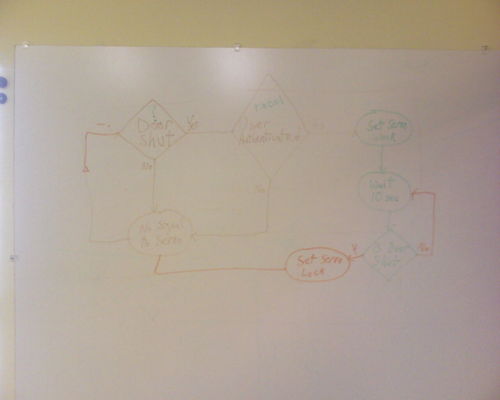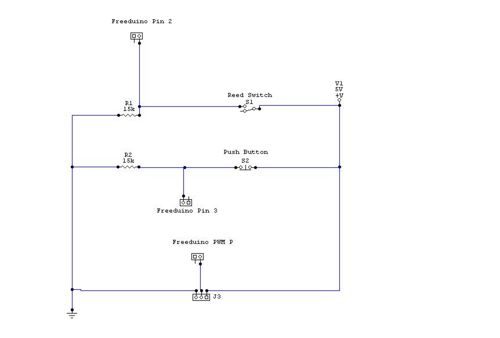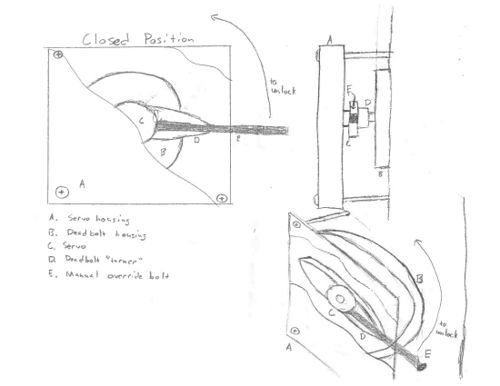USB Auth
Here's the video of the project: http://www.youtube.com/watch?v=Fa5RuWM1fEM
Contents
[hide]USB Authentication
Pros
Each USB device has a unique serial ID. USB keys are cheap, readily available, and many can fit on a standard metal keyring.
Cons
Implementation
Authentication Flow
- User inserts key into USB hub hooked to a PC
- Computer reads serial ID of key
- Computer compares serial ID to list of valid serial ID in a table \ DB \ Flat File
- If good, computer writes data ("Unlock!") to USB line of Microcontroller
- Microcontroller instructs servo to go to unlocked position for 5-10 seconds.
The flowchart for the circuit is below.
Parts List
- Servo $12
- Tubberware $6
- Freeduino Development Board $36
- Breadboard $5(?)
- Solder, Soldering Iron (On Hand)
- 15k Ohm Resistors (On Hand)
- Button (On Hand)
- Powered USB Hub ? (Necessary: for powering Freeduino with only USB and a laptop)
- Unpowered UBS Hub (Optional: Hub to put outside of door to plug USB keychains into)
Electrical Interface
Electrical Interface by Omegix
Note: "Freeduino PWM Pin P" Should be "Freeduino PWM Pin 9"
Mechanical Interface
Mechanical Override
Mechanical Interface design by Gregabyte
Note: Mechanical override will not be implemented till after Phreaknic Omegix 14:58, 21 October 2008 (CDT)
The idea here is to have a servo attached to a standard deadbolt. The microcontroller will need to not only receive a signal from the computer, but also sense a window-open detector, and control a servo.
If you were to attach the stick to the deadbolt turner or the plastic connected to the servo motor shaft, that would allow for a manual unlocker for the door in the event of a power failure
This image from Gregabyte shows a mechanical override system that could be implemented for under $20
Code
USB Reader Code
Coded by Brimstone
#!/bin/sh
# variables!
mymu=A6005ycb
mydev=/dev/ttyUSB0
mydb=usb-keys.txt
# first, define some common functions
function lsserial {
lsusb -v | awk '/iSerial/ {if ($2 == "3" || $2 == "2") {print $3}}'
}
# figure out whats attached
# check for our microcontroller
if [ $(lsserial | grep -c $mymu) = 0 ] ; then
echo -n "I don't see the microcontroller "
if [ -e $mydev ]; then
echo "but we have a $mydev ?"
else
echo
fi
exit 1
else
if [ ! -e $mydev ]; then
echo "I see the microcontroller, but no $mydev"
exit 1
fi
fi
if [ -e $mydb ] ; then
echo "Found serials for the following people:"
awk -F, '{print $1}' $mydb
else
echo "Didn't find keyfile $mydb"
exit 1
fi
# all good, lets go
preserial=$(lsserial | grep -v $mymu)
if [ -n "$preserial" ]; then
echo "I've detected the following serial devices already:"
echo $preserial
fi
echo "Ready and waiting"
# main loop that watches /var/log/messages
(
tail -n 0 -f /var/log/messages | awk '/new.*USB device/ {print "Attached"; fflush()} /USB disconnect/ {print "Dettached"; fflush()}'
) | (
# main loop that reads that cleaned /var/log/messages
while read cmd; do
if [ $cmd == "Attached" ] ; then
for ser in $(lsserial | grep -v $mymu); do
echo "Checking for $ser in flat file"
if [ $(grep -c $ser $mydb) = 1 ]; then
name=$(awk -F, "/$ser/ {print \$1}" $mydb)
echo "Unlocking for $name!"
echo -n U > $mydev
error=$?
if [ $error != 0 ]; then
echo "There was an error ($error) writing to $mydev"
fi
else
echo "Didn't find it in flat file"
fi
done
else
echo "Got $cmd but nothing implemented for it"
fi
done
)
Freeduino Code
Coded by Omegix
#include <Servo.h>
#define interrupt1PinA 3
volatile unsigned int interrupt1Value = 0;
char incomingChar = 0;
Servo myServo;
int pos;
int DoorSensePin = 2; //this is the PIN that the reed switch is connected to
int lockedPosition = 115; //This is the value that the servo wants to be at the correct physical position
int unlockedPosition = 28; //This is the value that the servo wants to be at the correct physical position
boolean HasForceUnlockHappened = 0; //this is used by the interrupt routine as a workaround to using timers
void setup()
{
Serial.begin(9600);
Serial.flush();
myServo.attach(9); // attaches the servo on pin 9 to the servo object
Lock(); //default to locked position at powerup
//myServo.write(28); //default to locked at powerup
pinMode(DoorSensePin, INPUT); //designate pin2 as a sensing (input) pin
pinMode(interrupt1PinA, INPUT);
attachInterrupt(1, ForceUnlock, HIGH); //when interrupt happens, run ForceUnlock function
}
void ForceUnlock() //it is important that no timer related functions happen during an interrupt routine
{
Serial.println("Force Unlock Button Pressed! Interrupt Called!");
myServo.write(unlockedPosition); //cannot call regular Unlock function as it has a delay() call
HasForceUnlockHappened = 1;
}
void loop()
{
//Serial.println("In Main Loop"); //TROUBLESHOOTING LINE
if (HasForceUnlockHappened == 1) //if an interrupt driven ForceUnlock has happened, then need to WaitToLock
{
HasForceUnlockHappened = 0; //reset till next interrupt
WaitToLock();
}
if (Serial.available() > 0)
{
incomingChar = Serial.read();
Serial.print("I recieved: ");
Serial.println(incomingChar, DEC);
//Serial.print("The DoorSense Value is: ");
//Serial.println(IsDoorOpen(), DEC);
// Code for Unlocking Door. Unlock does not care if door is closed or not.
if (incomingChar == 85) //"U" is 85 in DEC. U is for Unlock
{
Serial.println("Unlocking!");
Unlock();
}
//Code for Locking Door. Lock cares if door is open or closed.
if (incomingChar == 76) //"L" is 76 in DEC. L is for Lock
{
if (IsDoorOpen() == 0)
{
Serial.println("Locking!");
Lock();
}
if (IsDoorOpen() == 1) { Serial.println("Door is Open!!"); }
}
}// if serial end
}//loop end
//IsDoorOpen should return a 1 if Door is Open, and a 0 if Door is Closed.
boolean IsDoorOpen()
{
if (digitalRead(DoorSensePin) == 1) { return 1; }
if (digitalRead(DoorSensePin) == 0) { return 0; }
}
void Unlock()
{
myServo.write(unlockedPosition);
delay(100);
WaitToLock();
}
void Lock()
{
myServo.write(lockedPosition);
}
//This function will loop until the door is closed for 5 seconds and then Lock.
void WaitToLock()
{
BeginWaitingToLock:
while (IsDoorOpen() == 1) { /* Serial.println("Door Needs to Close."); /* do nothing */ }
//At this point Door should have shut
Serial.println("Door has been shut! Waiting 5 seconds.");
delay(1000 * 5); //wait 5 seconds
if (IsDoorOpen() == 0) // if door is still closed after delay, then lock
{
Lock();
}
if (IsDoorOpen() == 1)
{
Serial.println("Door Did not remain shut. Starting over loop.");
goto BeginWaitingToLock;
}
}


